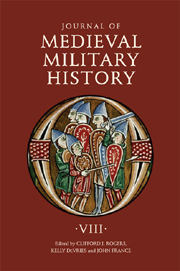Book contents
- Frontmatter
- Contents
- 1 People against Mercenaries: The Capuchins in Southern Gaul
- 2 The Last Italian Expedition of Henry IV: Re-reading the Vita Mathildis of Donizone of Canossa
- 3 Jaime I of Aragon: Child and Master of the Spanish Reconquest
- 4 Numbers in Mongol Warfare
- 5 Battlefield Medicine in Wolfram's Parzival
- 6 Battle-Seeking, Battle-Avoiding or perhaps just Battle-Willing? Applying the Gillingham Paradigm to Enrique II of Castile
- 7 Outrance and Plaisance
- 8 Guns and Goddams: Was there a Military Revolution in Lancastrian Normandy 1415–50?
- The Name of the Siege Engine trebuchet: Etymology and History in Medieval France and Britain
- Journal of Medieval Military History 1477–545
6 - Battle-Seeking, Battle-Avoiding or perhaps just Battle-Willing? Applying the Gillingham Paradigm to Enrique II of Castile
Published online by Cambridge University Press: 12 September 2012
- Frontmatter
- Contents
- 1 People against Mercenaries: The Capuchins in Southern Gaul
- 2 The Last Italian Expedition of Henry IV: Re-reading the Vita Mathildis of Donizone of Canossa
- 3 Jaime I of Aragon: Child and Master of the Spanish Reconquest
- 4 Numbers in Mongol Warfare
- 5 Battlefield Medicine in Wolfram's Parzival
- 6 Battle-Seeking, Battle-Avoiding or perhaps just Battle-Willing? Applying the Gillingham Paradigm to Enrique II of Castile
- 7 Outrance and Plaisance
- 8 Guns and Goddams: Was there a Military Revolution in Lancastrian Normandy 1415–50?
- The Name of the Siege Engine trebuchet: Etymology and History in Medieval France and Britain
- Journal of Medieval Military History 1477–545
Summary
On the night of 23 March 1369, just south of the city of Toledo in the central Iberian kingdom of Castile, one of the great medieval dramas played out as two bitter enemies faced each other for the first time in nearly fifteen years. One of these men was the legitimate monarch of Castile, Pedro I (1350–66, 1367–69), better known to history as Pedro “the Cruel.” The other was his illegitimate half-brother and rival for the throne, Enrique II (1366–67, 1369–79).
After suffering defeat in battle nine days earlier, Pedro had taken refuge in the nearby castle of Montiel, from which the encounter took its name. While attempting to escape through the siege lines set up by his enemy, he and a few retainers were captured by French troops serving Enrique, one of whom took Pedro to his half-brother's tent. The scene that followed is recounted with certain key variations by several contemporaries, including the most famous Spanish chronicler of the age, Pedro López de Ayala (d.1407), and his even more famous contemporary from the Low Countries, Jean Froissart (d.c.1405). Enrique soon arrived fully armed and asked in a loud voice, “Where is the son of a Jewish whore who calls himself king of Castile?” Without hesitation, Pedro replied, “Thou art the son of a whore, I am the son of Alfonso.” Grappling, the two tumbled to the ground, but when the larger Pedro appeared to gain an advantage others quickly intervened, ending any pretense of a fair fight by giving Enrique time to draw his dagger and use it.
- Type
- Chapter
- Information
- Journal of Medieval Military History , pp. 131 - 154Publisher: Boydell & BrewerPrint publication year: 2010

